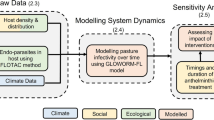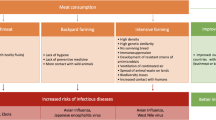Abstract
Cryptosporidium and Eimeria are intestinal parasites which are sensitive to the surroundings, behaviour and well-being of their host. In the present study, a range of factors related to farm management systems, environment, housing and herd characteristics were investigated with regard to alterations in oocyst excretion in cattle, using a mixed-effects model. Information and samples for three age categories were obtained from 45 Estonian dairy farms, located in 15 counties. Leaving the calf with the mother after birth reduced the risk of shedding higher levels of Cryptosporidium (OR = 0.20) and Eimeria (OR = 0.68) oocysts in all animals. The calves younger than 3 months kept on farms housing at least 150 animals had less risk (OR = 0.39) of producing higher numbers of Cryptosporidium oocysts. A somewhat lower infection level was observed in 3- to 12-month-old animals housed in separate buildings (OR = 0.64). The chance of shedding higher levels of Eimeria doubled (OR = 2.27) in cattle older than a year in case a vacancy period was used before replacing animals in pens and tripled (OR = 2.94) when the relative humidity exceeded 75% in the cowshed. Winter reduced the odds (OR = 0.25) of shedding Eimeria oocysts in the oldest animals compared to the fall season. Simple changes in handling and housing of cattle may produce a positive effect on controlling coccidian infections in Estonian dairy herds.


Similar content being viewed by others
References
Abrahamsen MS (1998) Bovine T cell responses to Cryptosporidium parvum infection. Int J Parasitol 28:1083–1088
Anderson BC (1986) Effect of drying on the infectivity of cryptosporidia-laden calf faeces for 3- to 7-day old mice. Am J Vet Res 47:2272–2273
Atwill ER, Harp JA, Jones T, Jardon PW, Checel A, Zylstra M (1998) Evaluation of periparturient dairy cows and contact surfaces as a reservoir of Cryptosporidium parvum for calfhood infection. Am J Vet Res 59:1116–1121
Autzen S, Maddox-Hyttel C, Virge H, Monrad J (2002) Infektion med Eimeria-arter hos kalve. Vurdering af risikofaktorer og sammenhæng mellem diarré og oocystudskillelse. Dansk VetTidskr 85:6–10
Benz GW, Ernst JV (1976) Alkaline phosphatase activities in intestinal mucosa from calves infected with Cooperia punctata and Eimeria bovis. Am J Vet Res 37:895–899
Besser TE, Gay CC, Pritchett L (1991) Comparison of three methods of feeding colostrum to dairy calves. JAVMA 198:419–422
Cox FEG (1998) Control of coccidiosis: lessons from other sporozoa. Int J Parasitol 28:165–179
Davis LR, Herlich H, Bowman GW (1959a) Studies on experimental concurrent infections of dairy calves with coccidia and nematodes. I. Eimeria spp. and the small intestinal worm Cooperia punctata. Am J Vet Res 20:281–286
Davis LR, Herlich H, Bowman GW (1959b) Studies on experimental concurrent infections of dairy calves with coccidia and nematodes. II. Eimeria spp. and the medium stomach worm Ostertagia ostertagi. Am J Vet Res 20:487–489
Davis LR, Herlich H, Bowman GW (1960a) Studies on experimental concurrent infections of dairy calves with coccidia and nematodes. III. Eimeria spp. and the threadworm Strongyloides papillosus. Am J Vet Res 21:181–187
Davis LR, Herlich H, Bowman GW (1960b) Studies on experimental concurrent infections of dairy calves with coccidia and nematodes. IV. Eimeria spp. and the small hairworm Trichostrongylus colubriformis. Am J Vet Res 20:188–194
Daugschies A, Najdrowski M (2005) Eimeriosis in cattle: current understanding. J Vet Med 52:417–427
Daugschies A, Böse R, Marx J, Teich K, Friedhoff KT (2002) Development and application of a standardized assay for chemical disinfection of coccidia oocysts. Vet Parasitol 103:299–308
Enemark HL, Ahrens P, Lowery CJ, Thamsborg SM, Enemark JM, Bille-Hansen V, Lind P (2002) Cryptosporidium andersoni from a Danish cattle herd: identification and preliminary characterisation. Vet Parasitol 107:37–49
Fitzgerald PR (1980) The economic impact of coccidiosis in domestic animals. Adv Vet Sci Comp Med 24:121–143
Gräfner G, Graubmann H-D, Schwartz K, Hiepe TH, Kron A (1985) Weitere Untersuchungen zu Vorkommen, Epizootiologie und Bekämpfung der Eimeria-Kokzidiose des Rindes unter den Bedingungen der intensiven Stallhaltung. MhVet-Med 40:41–44
Henriksen S, Korsholm H (1984) Parasitologisk undersøgelse af fæcesprøver. Konstruktion og anvendelse af et enkelt opbygget tællekammer. Dansk Vet Tidskr 67:1193–1196
Henriksen SA, Pohlenz JFL (1981) Staining of cryptosporidia by a modified Ziehl-Neelsen. Acta Vet Scand 22:594–596
Helle O (1970) Winter resistant oocysts in the pasture as a source of coccidial infection in lambs. Acta Vet Scand 11:545–564
Klockiewicz M, Jaba J, Tomczuk K, Janecka E, Sadzikowski AB, Rypula K, Studzinska M, Malecki-TePicht J (2007) The epidemiology of calf coccidiosis (Eimeria spp.) in Poland. Parasitol Res 101:121–128
Le Jan C (1996) Cellular components of mammary secretions and neonatal immunity: a review. Vet Res 27:403–417
Lentze T, Hofer D, Gottstein B, Gaillard C, Busato A (1999) Häufigkeit und Bedeutung von Endoparasiten bei Kä lbern in Schweizer Mutterkuhbetrieben. Dtsch Tierärztl Wochenschr 106:269–308
Long PL (1973) Pathology and pathogenicity of coccidial infections. In: Hammond DM, Long PL (eds) The Coccidia. Eimeria, Isospora, Toxoplasma and related genera. University Park Press, Baltimore, pp 254–294
Maddox-Hyttel C, Langkjaer RB, Enemark HL, Vigre H (2006) Cryptosporidium and Giardia in different age groups of Danish cattle and pigs-occurrence and management associated risk factors. Vet Parasitol 141:48–59
Marquardt WC, Senger CM, Seghetti L (1960) The effect of physical and chemical agents on the oocysts of Eimeria zuernii (Protozoa, coccidia). J Protozool 7:186–189
Matjila PT, Penzhorn BL (2002) Occurrence and diversity of bovine coccidia at three localities in South Africa. Vet Parasitol 104:93–102
Newby TJ, Stokes CR, Bourne FJ (1982) Immunological activities of milk. Vet Immunopathol 3:67–94
Oetjen BD (1993) Management of coccidiosis in dairy calves and replacement heifers. Comp Cont Edu Pract Vet 15:891–895
Pentjärv A, Kruus M, Tisler R (eds) (2005) Eesti Jõudluskontrolli aastaraamat. Kirjastus Elmatar, Tartu
Robertson LJ, Gjerde BK (2006) Fate of Cryptosporidium oocysts and Giardia cysts in the Norwegian aquatic environment over winter. Microb Ecol 52:597–602
Roepstorff A, Nansen P (1998) Epidemiology, diagnosis and control of helminth parasites of swine. FAO Animal Health Manual, Rome, pp 51–56
Sánchez RO, Romero JR, Founroge RD (2008) Dynamics of Eimeria oocyst excretion in dairy calves in the Province of Buenos Aires (Argentina), during their first 2 months of age. Vet Parasitol 151:133–138
Svensson C, Uggla A, Pehrson B (1994) Eimeria alabamensis infection as a cause of diarrhoea in calves at pasture. Vet Parasitol 53:33–43
Sherwood D, Angus KW, Snodgrass DR, Tzipori S (1982) Experimental cryptosporidiosis in laboratory mice. Infect Immun 38:471–475
Trotz-Williams LA, Martin SW, Leslie KE, Duffield T, Nydam DV, Peregrine AS (2008) Association between management practices and within-herd prevalence of Cryptosporidium parvum shedding on dairy farms in southern Ontario. Prev Vet Med 83:11–23
Veermäe I, Poikalainen V, Praks J (2001) Cold loose housing of diary cows in Estonia. Animal Welfare considerations in livestock housing systems. International Symposium of the 2nd Technical Section of G.I.G.R. Poland, p. 285–291
Webster AJ (1983) Environmental stress and the physiology, performance and health of ruminants. J Anim Sci 57:1584–1593
Xiao L, Herd RP (1994) Infection patterns of Cryptosporidium and Giardia in calves. Vet Parasitol 55:257–262
Acknowledgements
The authors thank the veterinarians for assistance in sample collection and the farms that participated in the research. Special thanks to Charlotte Hyttel for help with parasitological methods, Toomas Orro for statistical advice and Kerli Raaperi for practical help. Funding was provided by the Estonian University of Life Sciences, Estonian Ministry of Education and Research (project 0170165) and EU project 1.0101-0167 Graduate School in Biomedicine and Biotechnology, coordinated by SA Innove.
Author information
Authors and Affiliations
Corresponding author
Additional information
Brian Lassen: main contributor to this work
Acknowledgement of funding
Funding was provided by the Estonian University of Life Sciences, Estonian Ministry of Education and Research (project 0170165) and EU project 1.0101-0167 Graduate School in Biomedicine and Biotechnology, coordinated by SA Innove.
Rights and permissions
About this article
Cite this article
Lassen, B., Viltrop, A. & Järvis, T. Herd factors influencing oocyst production of Eimeria and Cryptosporidium in Estonian dairy cattle. Parasitol Res 105, 1211–1222 (2009). https://doi.org/10.1007/s00436-009-1540-8
Received:
Accepted:
Published:
Issue Date:
DOI: https://doi.org/10.1007/s00436-009-1540-8




